METALS AND NON-METALS for Class 8 SCIENCE
Introduction
Apne aas-paas hum bahut saare materials dekh sakte hai jaise iron, aluminium, copper, etc. Class 6 mein hamne kuchh materials ko unki properties ke basis par groups mein divide kiya tha. Materials ko metals aur non-metals mein bhi divide kiya gaya. Iss chapter mein hum metals aur non-metals ki physical properties jaise malleability, ductility, conductivity, etc. ke baare mein padhenge. Iss chapter mein hum inki chemical properties ke baare mein bhi padhenge jaise yeh water, acid aur bases ke saath kaise react karte hai, displacement reaction kya hai, etc. Hum yaha metals aur non-metals ke uses aur unke differences ke baare mein bhi padhenge.
Metals
Aise material jo hard, malleable, ductile, shiny aur sonorous hote hai unko metals kehte hai. Metals ke kuchh examples hai- iron, copper, aluminium, calcium, magnesium, silver, gold, etc.
Physical Properties Of Metals
MalleabilityMetals malleable hote hai. Malleability metals ki aisi property hai jiski vajah se hum metals ko thin sheets mein convert kar sakte hai.
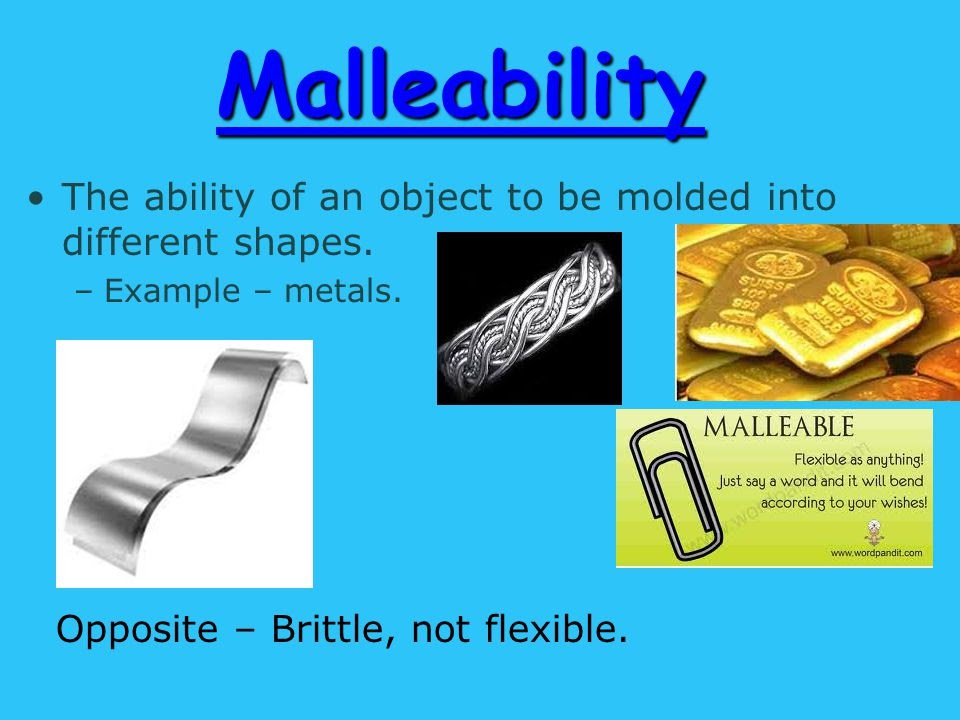
Eg- Hum kitchen mein jo aluminium foil use karte hai usko bhi beat karke hi thin sheets mein convert kiya jata hai. Sweets par jo silver foil decoration ke liye use kiya jata hai vo banana bhi malleability ki property se hi possible hai.
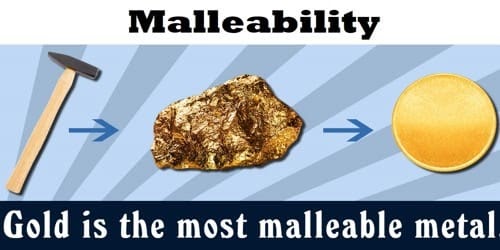
Good conductors of heat and electricity
Metals heat aur electricity ke good conductor hote hai. Yeh heat aur electricity ko easily pass hone dete hai. Eg- Metals jaise iron rod, nail, copper wire, etc. electricity ke good conductors hote hai.
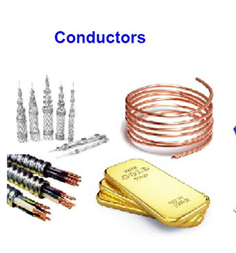
Ductility
Yeh metal ki aisi property hai jisse hum kisi bhi metal ko thin wires mein convert kar sakte hai. Eg- Aluminium aur copper wire jo hum electric connections mein use karte hai vo bhi ductility ki property se hi banaye jate hai.

Sonorous
Metals sonorous hote hai. Yeh hit karne par melodious aur ringing sounds produce karte hai.
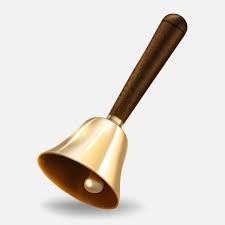
Lustrous
Metals lustrous hote hai. Yeh light ko reflect karte hai aur shine karte hai. Isliye jewellery banane ke liye metals ka use kiya jata hai.
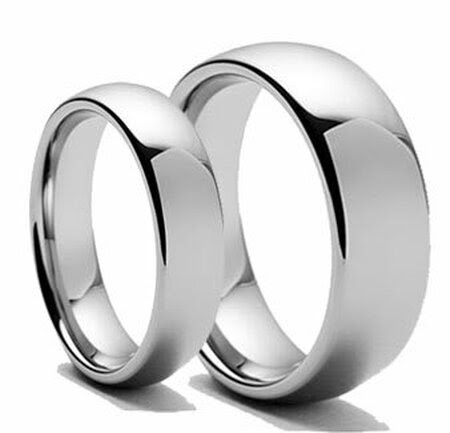
Hardness
Metals generally hard hote hai aur solid form mein paaye jate hai lekin sodium aur potassium soft metals hai aur knife se cut kiye ja sakte hai aur mercury ek aisa metal hai jo room temperature par liquid state mein paya jata hai.
Non-Metals
Aise materials jo metals ke opposite properties show karte hai unko non-metals kehte hai. Eg- sulphur, carbon, oxygen, etc.
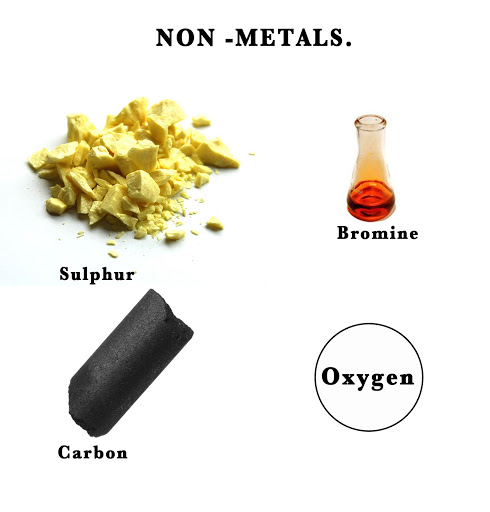
Physical Properties Of Non-Metals
POINT 1
Metals: Those materials which possess the characteristic of being hard, shiny, malleable, fusible, ductile, etc. are termed as metal.
Non-metals: Non-metals are those elements, which do not exhibit the properties of metals.
Conductor: Conductors are the materials or substances which allow electricity to flow through them.
Ductility: The property which allow the metals to be drawn into wires is called ductility.
Malleability: The property by virtue of which metals can be beaten into thin sheets is called malleability.
Sonorous: Sonorous is a property of metal and when metal strikes each other or are struck with a hard material, they produce a ringing sound.
.
Chemical properties of Metals and Non-metals
1. Reaction with oxygen
For Metals: Metals jab oxygen ke sath react karte hai toh metallic oxides banate hai. Eg- Hum apne aas paas dekhte hai ki iron par rust lag jata hai. Aisa isliye hota hai kyonki iron ek metal hai aur wo air mein present oxygen ke saath react karta hai. Yeh air aur moisture ke sath react karke iron oxide ki ek layer bana deta hai. Iski equation hum niche dekh sakte hai.
Ab hum iron par lagne vale rust ke nature ko janne ke liye ek activity perform karenge.
Activity- Testing the nature of metal oxides
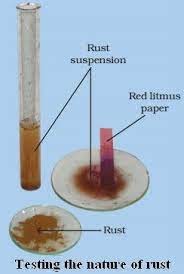

Jaise iron ko air mein expose karne par us par rust lag jata hai aise hi jab hum kisi copper vessel ko bahut long time ke liye air mein expose karte hai toh copper bhi air aur moisture ke sath react karta hai aur uske upar copper hydroxide aur copper carbonate ki ek dull green layer aa jati hai.

For Non-Metals: Non-metals bhi air aur moisture ke sath react karte hai aur oxides banate hai. Lekin yeh oxides acidic in nature hote hai. Ab hum iske nature ko test karne ke liye bhi ek activity perform karenge.
Activity - Testing the nature of non-metal oxides
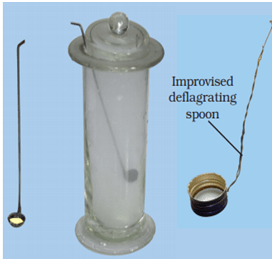
Sulphur aur oxygen ke reaction se ek product form hota hai jisko hum sulphur dioxide kehte hai aur jab is sulphur dioxide ko water mein mix kiya jata hai toh sulphurous acid banta hai jo blue litmus paper ko red kar deta hai.

2. Reaction with water
For Metals: Kuchh metals water se bahut jyada aur fast react karte hai. Eg- Sodium water ke sath bahut vigorously react karta hai. Lekin kuchh metals aise bhi hote hai jo water ke sath bahut slowly react karte hai. Eg- Iron water ke sath bahut slowly react karta hai.For Non-metals: Non-metals generally water ke sath react nahi karte lekin kuchh non-metals aise hote hai jo air ke sath bahut jyada reactive hote hai isliye unko water mein store kiya jata hai. Eg- Phosphorous ek bahut reactive metal hai. Yeh air ke contact mein aate hi easily fire catch kar leta hai. Isliye isko water mein store karke rakha jata hai.
3. Reaction with acids
Ab hum dekhte hai ki metals aur non-metals acids ke sath kaisa behave karte hai. Iske liye hum ek activity perform karenge.
Activity
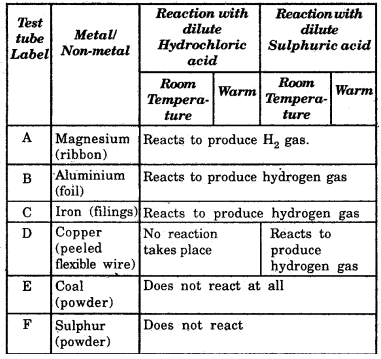
For Non-metals: Non-metals generally acids ke sath react nahi karte.
4. Reaction with bases
For Metals: Metals sodium hydroxide ke sath react karke hydrogen gas release karte hai, i.e. metals bases ke sath react karte hai aur hydrogen gas release karte hai.For Non-metals: Bases ke sath non-metals ke reactions complex hote hai.
5. Displacement Reactions
Ek reaction mein jab ek metal dusre metal ko uske hi compound mein se replace kar deta hai toh usko displacement reaction kehte hai.Eg- copper sulphate aur zinc ke reaction mein zinc copper ko replace kar deta hai aur copper sulphate ka blue color disappear ho jata hai aur copper ka powdery red mass test tube ya beaker ke bottom par settle down ho jata hai.

Note: Kisi bhi reaction mein ek more reactive metal hi less reactive metal ko displace kar sakta hai. Less reactive metal kabhi bhi more reactive metal ko displace nahi kar sakta.
POINT 2
Displacement reaction: Displacement reaction is a chemical reaction in which a more reactive element displaces a less reactive element from its compound.
Uses Of Metals
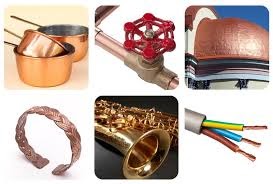
Uses Of Non-Metals
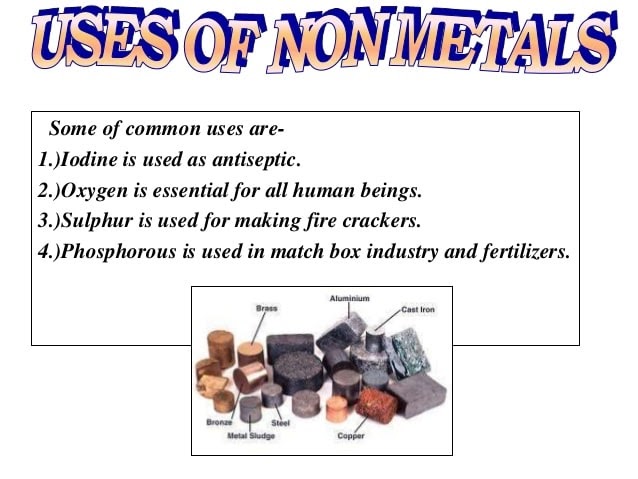
IMPORTANT DIFFERENCES

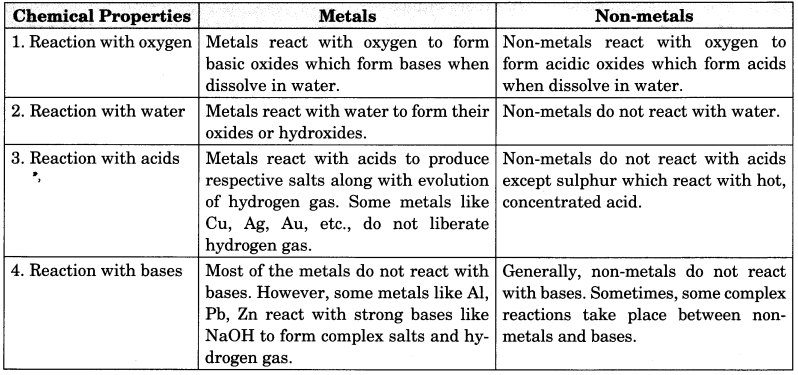
SUMMARY
1. Metals are lustrous whereas non-metals have no lustre.
2. Generally, metals are malleable and ductile. Non-metals do not have these properties.
3. Generally, metals are good conductors of heat and electricity but non-metals are poor conductors.
4. On burning, metals react with oxygen to produce metal oxides which are basic in nature. Non-metals react with oxygen to produce non- metallic oxides which are acidic in nature.
5. Some metals react with water to produce metal hydroxides and hydrogen gas. Generally, nonmetals do not react with water.
6. Metals react with acids and produce metal salts and hydrogen gas. Generally, non-metals do not react with acids.
7. Some metals react with bases to produce hydrogen gas.
8. More reactive metals displace less reactive metals from their compounds in aqueous solutions.
9. Metals and non-metals are used widely in every day life.